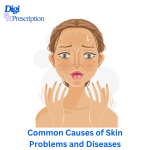
Skin problems and diseases can affect anyone, often causing discomfort, embarrassment, and sometimes long-term health concerns. These conditions can arise from various factors, including lifestyle habits, environmental exposure, and underlying health conditions. Understanding the common causes of skin problems can help individuals take preventative measures and seek appropriate treatments. Here are some common causes:
1. Sun Exposure and Tanning
Excessive sun exposure, especially without protection, is one of the leading causes of skin problems. It can lead to sunburn, premature aging (wrinkles, age spots), and an increased risk of skin cancer, including melanoma. Ultraviolet (UV) radiation from the sun damages the skin cells, accelerating aging and altering DNA, which can cause mutations leading to skin cancers.
2. Poor Skincare and Hygiene
Neglecting proper skincare practices or using harsh chemicals can irritate the skin. Over-washing or not moisturizing regularly can strip the skin of its natural oils, leading to dryness, redness, and irritation. Additionally, clogged pores due to excess oil production or failure to remove makeup can lead to acne or other skin infections.
3. Dietary Factors
What we eat plays a significant role in skin health. A poor diet high in processed foods, sugar, and unhealthy fats can contribute to acne, eczema, and other skin conditions. On the other hand, a balanced diet rich in antioxidants, vitamins (like vitamin A and C), and omega-3 fatty acids can help maintain healthy skin.
4. Environmental Factors
Pollution, extreme weather conditions (cold, heat, or humidity), and exposure to allergens can irritate the skin. Airborne pollutants and chemicals can clog pores, leading to acne breakouts or inflammation. Cold air can dry out the skin, while high humidity can lead to fungal infections.
5. Genetics and Family History
Genetics can play a significant role in the development of skin diseases. Conditions like eczema, psoriasis, and acne can run in families. If your parents or siblings have experienced certain skin issues, you may be more likely to develop them too.
6. Hormonal Changes
Hormonal fluctuations, particularly during puberty, pregnancy, menstruation, or menopause, can lead to changes in the skin. Acne outbreaks, increased oil production, and other skin problems are common during these times. Hormonal imbalances can also lead to conditions like hirsutism (excessive hair growth) and melasma (dark patches).
7. Stress and Mental Health
Chronic stress can trigger or worsen certain skin conditions, such as eczema, psoriasis, and acne. Stress triggers the release of hormones like cortisol, which can increase oil production and inflammation in the skin. Emotional distress can also lead to habits like scratching, picking, or rubbing the skin, which may worsen existing conditions.
8. Allergic Reactions
Skin reactions can be caused by allergies to certain foods, medications, fabrics, or environmental factors like pollen or pet dander. Conditions like hives, eczema, and contact dermatitis are often the result of allergic reactions. It's important to identify allergens and avoid exposure to prevent flare-ups.
9. Infections
Bacterial, viral, and fungal infections can lead to various skin diseases. Conditions like impetigo, ringworm, and athlete's foot are caused by infections, while conditions like cold sores and shingles are viral infections that affect the skin. Poor hygiene or a weakened immune system can increase the likelihood of these infections.
10. Medical Conditions and Medications
Certain medical conditions, such as diabetes, autoimmune diseases (like lupus), and thyroid disorders, can cause skin problems. Medications, including steroids, can also have side effects that affect the skin, making it more prone to acne, thinning, or other issues.
11. Smoking and Alcohol Use
Tobacco use can decrease blood flow to the skin, leading to premature aging, wrinkles, and dull skin. Alcohol dehydrates the body, which can dry out the skin, making it more vulnerable to irritation and inflammation.
Conclusion:
Skin diseases and conditions are often caused by a combination of factors, ranging from lifestyle choices and environmental exposure to genetic predisposition and underlying health conditions. Regular skin care, protection from the sun, a balanced diet, and managing stress can significantly reduce the risk of skin problems. If you experience persistent or severe skin issues, it is always best to consult a healthcare professional for diagnosis and treatment.
References:
- American Academy of Dermatology – Common Skin Conditions. https://www.aad.org
- Mayo Clinic – Skin Conditions and Diseases. https://www.mayoclinic.org
- World Health Organization (WHO) – Skin and Subcutaneous Diseases. https://www.who.int
- National Institute of Arthritis and Musculoskeletal and Skin Diseases (NIAMS) – Skin Diseases. https://www.niams.nih.gov
- Centers for Disease Control and Prevention (CDC) – Skin Infections and Prevention. https://www.cdc.gov
